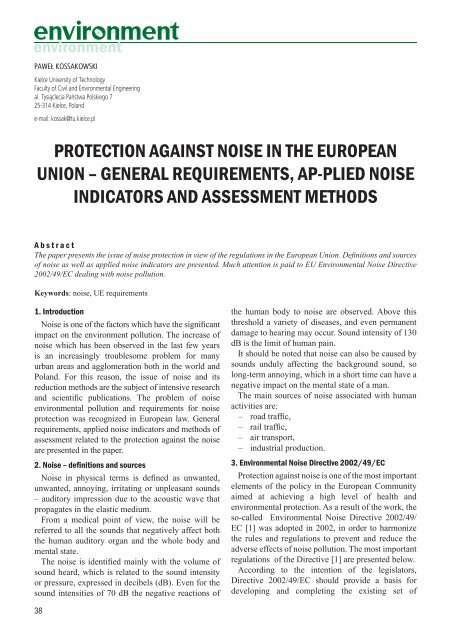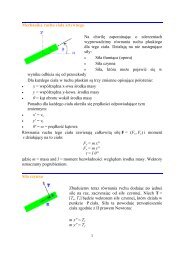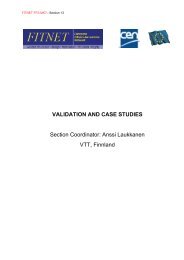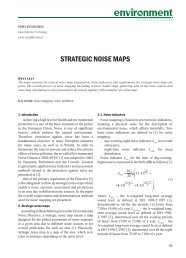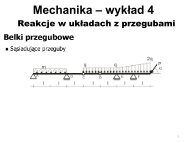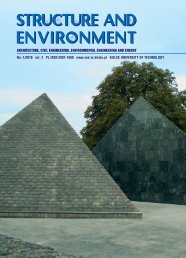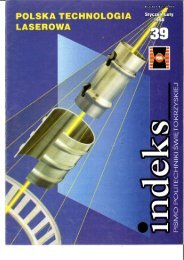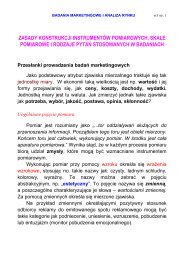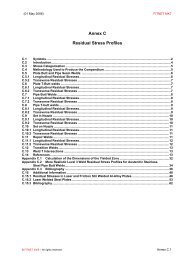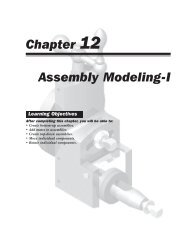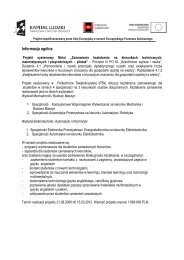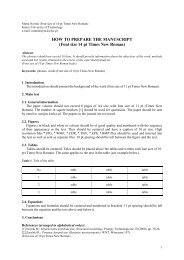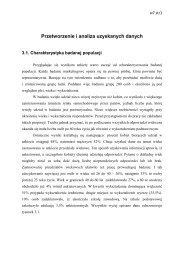STRUCTURE AND ENVIRONMENT STRUCTURE AND ...
STRUCTURE AND ENVIRONMENT STRUCTURE AND ...
STRUCTURE AND ENVIRONMENT STRUCTURE AND ...
Create successful ePaper yourself
Turn your PDF publications into a flip-book with our unique Google optimized e-Paper software.
PAWEŁ KOSSAKOWSKI<br />
Kielce University of Technology<br />
Faculty of Civil and Environmental Engineering<br />
al. Tysiąclecia Państwa Polskiego 7<br />
25-314 Kielce, Poland<br />
e-mail: kossak@tu.kielce.pl<br />
PROTECTION AGAINST NOISE IN THE EUROPEAN<br />
UNION – GENERAL REQUIREMENTS, AP-PLIED NOISE<br />
INDICATORS <strong>AND</strong> ASSESSMENT METHODS<br />
A b s t r a c t<br />
The paper presents the issue of noise protection in view of the regulations in the European Union. Definitions and sources<br />
of noise as well as applied noise indicators are presented. Much attention is paid to EU Environmental Noise Directive<br />
2002/49/EC dealing with noise pollution.<br />
Keywords: noise, UE requirements<br />
1. Introduction<br />
Noise is one of the factors which have the significant<br />
impact on the environment pollution. The increase of<br />
noise which has been observed in the last few years<br />
is an increasingly troublesome problem for many<br />
urban areas and agglomeration both in the world and<br />
Poland. For this reason, the issue of noise and its<br />
reduction methods are the subject of intensive research<br />
and scientific publications. The problem of noise<br />
environmental pollution and requirements for noise<br />
protection was recognized in European law. General<br />
requirements, applied noise indicators and methods of<br />
assessment related to the protection against the noise<br />
are presented in the paper.<br />
2. Noise – definitions and sources<br />
Noise in physical terms is defined as unwanted,<br />
unwanted, annoying, irritating or unpleasant sounds<br />
– auditory impression due to the acoustic wave that<br />
propagates in the elastic medium.<br />
From a medical point of view, the noise will be<br />
referred to all the sounds that negatively affect both<br />
the human auditory organ and the whole body and<br />
mental state.<br />
The noise is identified mainly with the volume of<br />
sound heard, which is related to the sound intensity<br />
or pressure, expressed in decibels (dB). Even for the<br />
sound intensities of 70 dB the negative reactions of<br />
the human body to noise are observed. Above this<br />
threshold a variety of diseases, and even permanent<br />
damage to hearing may occur. Sound intensity of 130<br />
dB is the limit of human pain.<br />
It should be noted that noise can also be caused by<br />
sounds unduly affecting the background sound, so<br />
long-term annoying, which in a short time can have a<br />
negative impact on the mental state of a man.<br />
The main sources of noise associated with human<br />
activities are:<br />
– road traffic,<br />
– rail traffic,<br />
– air transport,<br />
– industrial production.<br />
3. Environmental Noise Directive 2002/49/EC<br />
Protection against noise is one of the most important<br />
elements of the policy in the European Community<br />
aimed at achieving a high level of health and<br />
environmental protection. As a result of the work, the<br />
so-called Environmental Noise Directive 2002/49/<br />
EC [1] was adopted in 2002, in order to harmonize<br />
the rules and regulations to prevent and reduce the<br />
adverse effects of noise pollution. The most important<br />
regulations of the Directive [1] are presented below.<br />
According to the intention of the legislators,<br />
Directive 2002/49/EC should provide a basis for<br />
developing and completing the existing set of<br />
38


